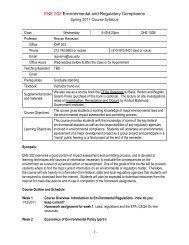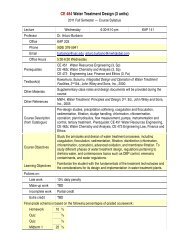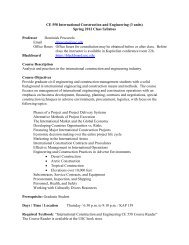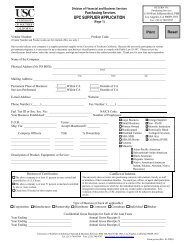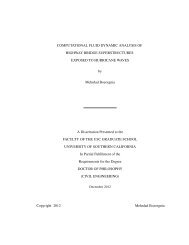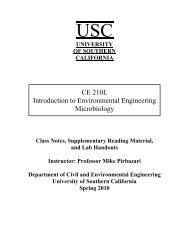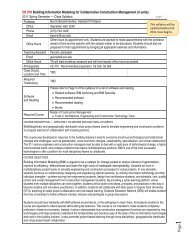CE 465 Course Syllabus - USC
CE 465 Course Syllabus - USC
CE 465 Course Syllabus - USC
You also want an ePaper? Increase the reach of your titles
YUMPU automatically turns print PDFs into web optimized ePapers that Google loves.
<strong>CE</strong> <strong>465</strong><br />
<strong>Course</strong> <strong>Syllabus</strong><br />
Spring 2013
Part I <strong>Course</strong> Organization
<strong>Course</strong> <strong>CE</strong> <strong>465</strong> Water Supply & Sewer System Design (3 units)<br />
2013 Spring Semester — <strong>Course</strong> <strong>Syllabus</strong><br />
Professor<br />
Dr. CC Wang<br />
Office<br />
KAP 230D<br />
Phone (626) 375-5451 (Cell)<br />
Email ccwang@usc.edu chunc.wang01@gmail.com<br />
Office Hours TBD<br />
Teaching Assistant<br />
Office<br />
Email<br />
Office Hours<br />
Blackboard<br />
TBD<br />
TBD<br />
TBD<br />
TBD<br />
https://blackboard.usc.edu/<br />
<strong>Course</strong> Description<br />
This course is designed to give seniors and first year graduate students in Civil/Environmental Engineering<br />
the ability to design the complete/comprehensive water supply and sewer systems (both sanitary sewer<br />
and storm drain), including all necessary pump station design.<br />
<strong>Course</strong> and Learning Objectives<br />
To study and analyze the design criteria of overall water supply and sewer system.<br />
The student will be able to:<br />
1. Understand the hydraulics of pressure pipe flow and open channel gravity flow;<br />
2. Perform the population projection for a water and sewer system of a specified city to be<br />
designed for.<br />
To study and analyze the wells and reservoir and service storage for the water supply system.<br />
The student will be able to:<br />
1. Evaluate the capacity of the water wells to be served as the source of the water supply;<br />
2. Design the size of the storage reservoir based on the design criteria selected for the water<br />
supply system;<br />
3. Design the capacity of the elevated storage reservoir requirement based on the different<br />
pumping modes of the day;<br />
4. Determine the optimum storage capacity for the water supply system @ various unit cost of<br />
electricity.<br />
To layout and design the water distribution system.<br />
The student will be able to:
1. Perform fire flow testing to ensure firewater requirement is met;<br />
2. Perform the Hardy Cross water network analysis to ensure the flow rate and pressure<br />
requirement are met;<br />
3. Selection of the proper piping material for the water distribution system;<br />
4. Analyze the water hammer problem in the water distribution system;<br />
5. Layout the looped water distribution system.<br />
To layout the gravity sanitary sewer and storm drain system.<br />
The student will be able to:<br />
1. Perform the hydraulic analysis for the partially full pipe system;<br />
2. Estimate the sanitary sewage flow rate based on the water supply requirement;<br />
3. Estimate the surface runoff based on the rational method;<br />
4. Perform layouts of both the sanitary and storm drain systems to eliminate the possible cross<br />
contamination with the potable water distribution system;<br />
5. Pipe sizing and pipe material selection based on various pipe trenching and external loadings.<br />
To layout and design the pump station.<br />
The student will be able to:<br />
1. Estimate the size of the required pump and lift stations both for the water and sewer systems;<br />
2. Estimate the total dynamic head (TDH) and horse power requirements for the pump station;<br />
3. Perform general arrangement of a pump station with multiple pumps and its selection on the<br />
number of pumps required for the system design<br />
Prerequisite<br />
<strong>CE</strong>453 Water Quality Control<br />
Class Day/Time/Location Tuesday/6:30 to 9:10 P.M./KAP 148<br />
Required Textbook<br />
Computer Usage<br />
Terence, J. McGhee, Water Supply and Sewerage, 6th Edition, Mc Graw-<br />
Hill.<br />
EPANET for Hardy Cross Water Distribution Analysis<br />
Weekly <strong>Course</strong> Schedule<br />
1. General outline of water supply & sewer systems<br />
2. Review of Hydraulics<br />
3. Population projection<br />
4. Water wells as water resource<br />
5. Distribution reservoir and service storage<br />
6. Water distribution network – Hardy Cross method<br />
7. Fire water requirement and flow testing<br />
8. Water Hammer analysis<br />
9. Pump station design & pump selection<br />
10. Wastewater flow estimate and analysis<br />
11. Storm runoff analysis - Rational method<br />
12. Sewer system design - Combined vs. separate system<br />
13. Loads on buried pipe<br />
14. Pipe selection and sewer appurtenances<br />
15. Any additional subjects that students requested<br />
Use your class time.
Grading Scheme<br />
Attendance<br />
15% Homework Assignments<br />
5% Class Participation & Discussion<br />
15% Term Project Progress Presentation (starting from mid-semester)<br />
20% Midterm Exam (1 st Exam – Water Supply System)<br />
20% Final Exam (2 nd Exam – Sewer System)<br />
25% Term Project (Design of a Complete System for a Small Community - Due<br />
on the Day of Final Exam)<br />
Regular attendance will not be taken. However, examination questions will include items covered in<br />
lectures and distributed handouts that are not covered in the textbook. Each student is responsible for all<br />
announcements and material covered in class.<br />
Late Work<br />
Weekly homework is due at 6:30 pm, one week after the assignment date.<br />
Solutions will be posted on the course Blackboard two weeks after the assignment date.<br />
Homework may be submitted after due date but before solutions are posted for 50% credit. Later<br />
submittals will not be accepted or graded.<br />
Use your class time.
Part II Detailed <strong>Course</strong><br />
Objectives
<strong>CE</strong> <strong>465</strong><br />
ENE<br />
Water Supply and Sewerage System Design<br />
<strong>USC</strong> | SONNY ASTANI DEPARTMENT OF CIVIL AND ENVIRONMENTAL ENGINEERING<br />
3 Units<br />
ABET <strong>Course</strong> <strong>Syllabus</strong><br />
<strong>Course</strong> Information, Textbook, and Supplementary Materials<br />
Capstone | Kernel<br />
<strong>Course</strong> Description: Fundamentals of analysis and design of steel structures; structural elements; simple and eccentric<br />
connections; design project.<br />
Capstone for: BS<strong>CE</strong> Design Kernel for: BS<strong>CE</strong> Environmental Required for: BSENE<br />
Prerequisite: <strong>CE</strong> 453 Water Quality Control<br />
Co-Requisite: None<br />
Required Textbook:<br />
Reference:<br />
Topics Covered<br />
Water supply and sewage<br />
treatment systems<br />
Learning Outcomes<br />
1. Hydraulics review and population prediction<br />
2. Water wells as water source<br />
3. Distribution reservoir and service storage<br />
4. Water distribution network - Hardy Cross method<br />
5. Firewater requirement and flow testing<br />
6. Water hammer analysis<br />
7. Pump station design and pump selection<br />
8. Wastewater flow estimate and analysis<br />
9. Storm runoff analysis - Rational method<br />
10. Sewer system design - Combined vs. Separate system<br />
11. Loads on buried pipe<br />
12. Pipe selection and sewer appurtenances<br />
Computer program<br />
applications<br />
13. Water supply network analysis - E-PLANET<br />
Lecture and Lab Schedule<br />
Lecture<br />
Lab<br />
Sessions per Week Duration per Session Sessions per Week Duration per Session<br />
1 3 hours n/a<br />
Page 1
<strong>CE</strong> <strong>465</strong><br />
ENE<br />
Water Supply and Sewerage System Design<br />
<strong>USC</strong> | SONNY ASTANI DEPARTMENT OF CIVIL AND ENVIRONMENTAL ENGINEERING<br />
3 Units<br />
Contribution of <strong>Course</strong> to Meeting the Professional Component<br />
Engineering Topics | Design<br />
Students will understand the design process and learn approaches used to solve various engineering problems that are<br />
representative of those found in a professional environment. They will practice decision-making skills as they apply their<br />
knowledge of basic sciences, mathematics, and the engineering sciences to convert resources optimally to meet the stated<br />
needs of a project.<br />
In this class, students will learn the fundamentals of analysis and design of steel structures, structural elements, and simple<br />
and eccentric connections. The course culminates with a design project.<br />
Engineering Topics | Other<br />
Constraints and Considerations. Students will understand the diverse constraints and considerations that are representative<br />
of what they will encounter in an engineering practice. This course covers the following topics:<br />
Economic | Environmental | Sustainability | Manufacturability | Ethical | Health and Safety | Social | Political | Energy<br />
Relation of <strong>Course</strong><br />
Objectives to Program Outcomes<br />
The Civil Engineering program is designed<br />
to teach beyond the technical content of the<br />
curriculum and prepare the students to<br />
utilize what they learn in a professional<br />
setting.<br />
This course contributes to the program<br />
outcomes as outlined in the adjacent table.<br />
<strong>Course</strong> Contribution to Program Outcomes (a-k)<br />
a. An ability to apply knowledge of mathematics, science, and<br />
engineering.<br />
b. An ability to design and conduct experiments, as well as to analyze<br />
and interpret data.<br />
c. An ability to design a system component or process to meet desired<br />
needs within realistic constraints such as economic, environmental,<br />
social, political, ethical, health and safety, manufacturability, and<br />
sustainability.<br />
<br />
Key<br />
Prepared by:<br />
Dr. CC Wang<br />
Professor of Civil and Environmental Engineering<br />
Date: Spring 2013<br />
Page 2


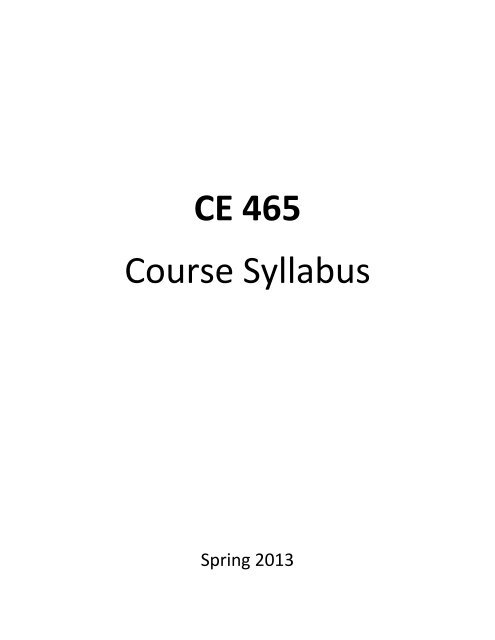

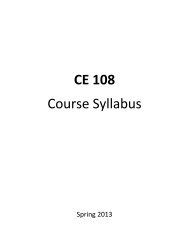
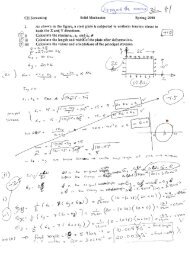
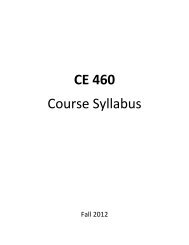
![Dr. Yan Xiao Bamboo Road Bridge can Support 16-Ton[ne] - USC](https://img.yumpu.com/37910641/1/190x245/dr-yan-xiao-bamboo-road-bridge-can-support-16-tonne-usc.jpg?quality=85)
